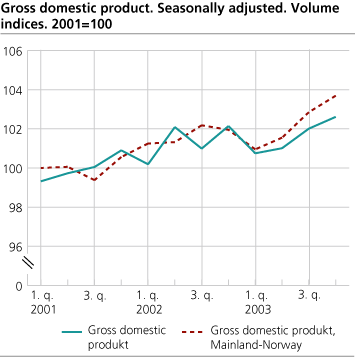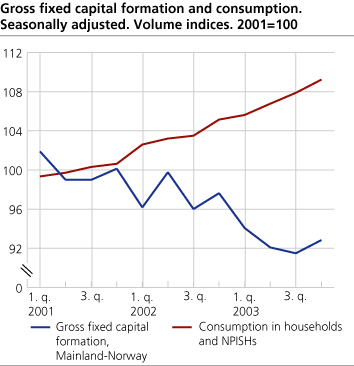Content
Published:
This is an archived release.
Growth in mainland economy
After a year of zero-growth, the mainland economy has been growing since the spring of 2003. According to seasonally adjusted figures from the Quarterly National Accounts (QNA), the Gross Domestic Product (GDP) for mainland Norway increased by 0.8 per cent from the 3rd to the 4th quarter, after increasing by 1.3 per cent the quarter before. The volume in GDP for mainland Norway grew by 0.7 per cent from 2002 to 2003, and the growth in total GDP was estimated at 0.3 per cent.
Statistics Norway will also publish final national accounts for 2001 and preliminary national accounts for 2002 ( Click here ). Revised national accounts show higher growth for both years than previously published.
The growth in mainland production in the 4 t h quarter can mainly be attributed to an increase in several service industries, of which wholesale and retail trade and business services contributed most significantly. Manufacturing's value added fell by 0.5 per cent in the 4 t h quarter, after an increase of 1.4 per cent in the 3 r d quarter. The decrease in the 4 t h quarter is primarily due to a decrease in manufacturing of machinery and equipment and in manufacturing of ships, oil platforms and modules.
Since the previous publication, the growth in GDP for mainland Norway for the 2 n d and 3 r d quarters has been revised with respective increases of 0.1 and 0.5 per cent. The revision in the 3 r d quarter is mainly due to new information regarding postal services and telecommunications industries.
Significant growth in household consumption expenditure
Preliminary figures for annual household consumption expenditure increased by 3.5 per cent from 2002 to 2003. Quarterly figures show an increase in household consumption expenditure of 1.2 per cent from the 3 r d to the 4 t h quarter, after an increase of 1.0 per cent from the 2 n d to the 3 r d quarter. Household commodity consumption grew by 1.7 per cent in the 4 t h quarter and service consumption grew by 1.1 per cent. After a trend of strong growth in household purchases of clothing and footwear throughout the first three quarters of 2003, growth was clearly weaker in the 4 t h quarter. The increase in commodity consumption for this period was primarily due to household purchases of personal vehicles and electricity.
The growth in disposable income for households and NPISH was 4.1 per cent from 2002 to 2003. The growth in total consumption expenditures for households and NPISH was 6.2 percent. This relationship led to a decrease in the sector's saving rate (saving as a portion of disposable income) from 9.4 per cent in 2002 to 7.5 per cent in 2003. For more information, see the institutional sector accounts 2001-2003 ( Click here ).
General government consumption expenditure grew by 1.3 per cent from 2002 to 2003. The 2.2 per cent growth in central government consumption expenditure was the main contributor to growth in general government, mainly due to hospital institutions' purchases of goods and services.
Increased investment activity
Seasonally adjusted figures for investments in fixed capital for mainland Norway show a decrease of 0.6 per cent from the 2 n d to 3 r d quarter, then went up by 1.5 per cent from the 3 r d to the 4 t h quarter. The increase from the 3 r d to the 4 t h quarter came first and foremost from a boost in investment activity within the service industries. Additionally, the figures suggest an increase in investments in dwellings and within manufacturing. For the entire year of 2003, investments in fixed capital in mainland Norway was down by 4.9 per cent. Manufacturing and service industries experienced a relatively strong downward trend. The decreases within manufacturing can be attributed to the 2002 completion of a few large investment projects within manufacturing of metals.
According to the preliminary figures, investment activity within gas and oil extraction and pipeline transport decreased by 9.7 per cent from the 3 r d to 4 t h quarter, after an increase of 1.9 per cent from the 2 n d to 3 r d quarter. For the total Norwegian economy, investments in fixed capital decreased by 2.8 per cent in the 4 t h quarter, after an increase of 1.5 per cent for the previous quarter.
Increased export of traditional goods
Seasonally adjusted figures for the export of traditional goods increased by 1.5 per cent in the 4 t h quarter of 2003 after an increase of 1.4 per cent in the 3 r d quarter. The increase from the 3 r d to 4 t h quarter was primarily due to an upturn in the export of machinery and equipment and refined oil products. From 2002 to 2003, export of traditional goods increased by 2.5 per cent.
Export of crude oil and natural gas fell by 5.3 per cent in the 3 r d quarter and continued to fall by another 0.5 per cent in the 4 t h quarter. In the annual figures, export fell by 0.5 per cent from 2002.
The volume of import of traditional goods fell by 0.4 per cent from the 2 n d to the 3 r d quarter, and then rose by 1.5 per cent in the 4 t h quarter. Total import grew by 1.8 per cent in 2003.
From the 2 n d to 3 r d quarter, a price increase for the import of traditional goods of 2.6 per cent occurred, followed by a 1.2 per cent increase from the 3 r d to the 4 t h quarter.
Decrease in employment and productivity
The total number of employed persons sank by 0.1 per cent in 4 t h quarter from the same period in 2002. The corresponding 3 r d quarter results yielded a 0.7 per cent decrease. Figures for the year as a whole show a reduction of 0.6 per cent in the number of employed persons. In 2003, the number of employed persons in manufacturing dropped by 4.6 per cent, and the number of employed persons in general government dropped by 0.5 per cent. Total man-hours fell by 1.2 per cent in 2003. Increased absences from work and reduced overtime have contributed to this reduction in total man-hours. The growth in GDP for mainland Norway from 2002 to 2003 was 1.8 per cent, as opposed to 2.7 per cent the year before.
Weak salary growth
Growth in salary and wages per full-time equivalent persons was calculated to be 3.8 per cent in 2003. Reduced overtime also brought down the growth in this figure. According to the accounts, the growth in compensation of employees per man-hour was 4.5 per cent. The annual growth in total compensation of employees was 3.1 per cent. The growth in total operating surplus and operating surplus for mainland Norway were 5.4 and 3.3 per cent, respectively.
| Gross domestic product 1. to 4. quarter 2003. Percentage change in volume from the previous period (seasonally adjusted) |
| 2001 | 2002 | 2003 | 1. quarter 2003 | 2. quarter 2003 | 3. quarter 2003 | 4. quarter 2003 | |||||||||||||||||||||||||||||||||
|---|---|---|---|---|---|---|---|---|---|---|---|---|---|---|---|---|---|---|---|---|---|---|---|---|---|---|---|---|---|---|---|---|---|---|---|---|---|---|---|
| Gross domestic product (GDP) | 2.7 | 1.4 | 0.3 | -1.4 | 0.3 | 1.0 | 0.6 | ||||||||||||||||||||||||||||||||
| Mainland-Norway | 2.1 | 1.7 | 0.7 | -1.0 | 0.6 | 1.3 | 0.8 | ||||||||||||||||||||||||||||||||
| Petroleum activities and ocean transport | 4.6 | 0.4 | -0.9 | -2.6 | -0.8 | 0.0 | -0.2 | ||||||||||||||||||||||||||||||||
| Final domestic use of goods and services | 0.8 | 2.4 | 0.9 | 1.7 | -4.8 | 2.7 | 1.4 | ||||||||||||||||||||||||||||||||
| Final consumption exp. of households and NPISHs | 1.8 | 3.6 | 3.7 | 0.5 | 1.1 | 1.0 | 1.3 | ||||||||||||||||||||||||||||||||
| Final consumption exp. of general government | 5.8 | 3.1 | 1.3 | 0.3 | 0.8 | -0.1 | 1.0 | ||||||||||||||||||||||||||||||||
| Gross fixed capital formation | -0.7 | -3.4 | -2.5 | -0.5 | -4.2 | 1.5 | -2.8 | ||||||||||||||||||||||||||||||||
| Exports | 5.0 | 0.1 | 0.1 | -2.6 | 3.6 | -2.1 | 2.0 | ||||||||||||||||||||||||||||||||
| Imports | 0.9 | 2.3 | 1.8 | 1.2 | -0.7 | -0.3 | 0.7 | ||||||||||||||||||||||||||||||||
| Total employed (per cent change from the same period the previous year) | 0.2 | 0.3 | -0.6 | -0.5 | -1.0 | -0.7 | -0.1 | ||||||||||||||||||||||||||||||||
Tables
Contact
-
Pål Sletten
E-mail: pal.sletten@ssb.no
tel.: (+47) 99 29 06 84
-
Ingunn Sagelvmo
E-mail: ingunn.sagelvmo@ssb.no
tel.: (+47) 40 90 26 32
-
Pia Tønjum
E-mail: pia.tonjum@ssb.no
tel.: (+47) 48 99 12 07
-
Kristian Gimming
E-mail: kristian.gimming@ssb.no
tel.: (+47) 91 88 39 06


